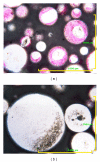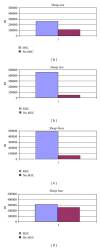Mesenchymal stem cells and platelet gel improve bone deposition within CAD-CAM custom-made ceramic HA scaffolds for condyle substitution
- PMID: 24073409
- PMCID: PMC3773948
- DOI: 10.1155/2013/549762
Mesenchymal stem cells and platelet gel improve bone deposition within CAD-CAM custom-made ceramic HA scaffolds for condyle substitution
Abstract
Purpose: This study evaluated the efficacy of a regenerative approach using mesenchymal stem cells (MSCs) and CAD-CAM customized pure and porous hydroxyapatite (HA) scaffolds to replace the temporomandibular joint (TMJ) condyle.
Methods: Pure HA scaffolds with a 70% total porosity volume were prototyped using CAD-CAM technology to replace the two temporomandibular condyles (left and right) of the same animal. MSCs were derived from the aspirated iliac crest bone marrow, and platelets were obtained from the venous blood of the sheep. Custom-made surgical guides were created by direct metal laser sintering and were used to export the virtual planning of the bone cut lines into the surgical environment. Sheep were sacrificed 4 months postoperatively. The HA scaffolds were explanted, histological specimens were prepared, and histomorphometric analysis was performed.
Results: Analysis of the porosity reduction for apposition of newly formed bone showed a statistically significant difference in bone formation between condyles loaded with MSC and condyles without (P < 0.05). The bone ingrowth (BI) relative values of split-mouth comparison (right versus left side) showed a significant difference between condyles with and without MSCs (P < 0.05). Analysis of the test and control sides in the same animal using a split-mouth study design was performed; the condyle with MSCs showed greater bone formation.
Conclusion: The split-mouth design confirmed an increment of bone regeneration into the HA scaffold of up to 797% upon application of MSCs.
Figures







References
-
- Wei G, Ma PX. Structure and properties of nano-hydroxyapatite/polymer composite scaffolds for bone tissue engineering. Biomaterials. 2004;25(19):4749–4757. - PubMed
-
- Cooke FW. Ceramics in orthopedic surgery. Clinical Orthopaedics and Related Research. 1992;(276):135–146. - PubMed
-
- Lucarelli E, Fini M, Beccheroni A, et al. Stromal stem cells and platelet-rich plasma improve bone allograft integration. Clinical Orthopaedics and Related Research. 2005;(435):62–68. - PubMed
-
- Berger G, Gildenhaar R, Ploska U. Rapid resorbable, glassy crystalline materials on the basis of calcium alkali orthophosphates. Biomaterials. 1995;16(16):1241–1248. - PubMed
-
- Daculsi G. Biphasic calcium phosphate concept applied to artificial bone, implant coating and injectable bone substitute. Biomaterials. 1998;19(16):1473–1478. - PubMed
Publication types
MeSH terms
Substances
LinkOut - more resources
Full Text Sources
Other Literature Sources
Miscellaneous

